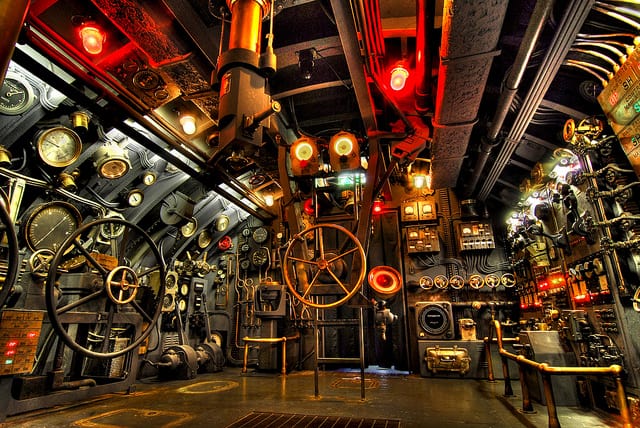It’s 3:00 a.m. and I am wide awake. Huge claps of thunder follow closely on what must be thousands of lightning strikes outside my window. I hate storms like these and, since I didn’t get to sleep before it started, I’ll be awake until after it ends. I try all my normal tricks: prayer, reading, rosary. Nothing. After hours awake, I reach for my iPad and queue up one of the two movies I have there. Downloaded years ago, I have seen these movies dozens, if not hundreds, of times. It’s time for another deep dive. What are the only movies on my iPad? Submarine movies. I love them.
I can’t keep myself from watching these underwater adventures. “The Hunt for Red October” never fails to pull me in. I love to watch Alec Baldwin and Sean Connery–worthy adversaries–save the world from nuclear annihilation. It’s the same with “K19: The Widowmaker,” starring Harrison Ford and Liam Neeson, where captain and crew must work together to keep the crippled boat from exploding and causing a war.
Still, even though I love these movies that doesn’t always mean I understand them. The dialogue in submarine movies is basically a foreign language to me: “Crazy Ivan!” “All stop full!” “All stop full, aye!” “Right full rudder, 30 degree down angle on the bow planes.” Umm, what?! But language aside, these films are–all at once– thrilling, confusing, scary, confining and strangely timeless. The Cold War froze over some twenty-odd years ago, but the remarkable narrative of a crew onboard a submarine lives on. Their life is portrayed as endlessly stifling and repetitive: we see the intimate – i.e. cramped -spaces shared by hundreds of sailors; the storage, planning and deployment of food and fresh water on board a ship suspended in a vast ocean; the intrigue involved with launching a missile from a strategically hidden location.
And reaching these locations is more than just a subplot for, at the heart of all submarine movies, is a story of navigation. Sean Connery and Harrison Ford (with their fake Russian accents) command their crews to steer through dangerous underwater canyons, skirt within yards of other ships and order the ascent of their boats into perilously thick ice formations. These submarine commanders utilize modern tools like sonar and rely on detailed maps drafted on generations of experience. In the dark, murky water at the bottom of cold canyons, they have no other choice but to trust these things. But navigating in the depths of the ocean requires more than just maps and modern technology: it demands a profound amount of trust.
The trust I see on the screen can be as foreign to me as the dialogue I hear. These naval captains do what I often can’t or won’t do in my own life, which is undoubtedly a lot less stressful and dangerous than theirs. These men steer without seeing. They rely on what they know has been true in the past and they place their faith in what they assume will be true in the future. Boldly, they keep moving forward, content with the limited knowledge they have of the present. This is a kind of bold trust that I wish I understood better, that I want to understand better, that I hope I can come to know more deeply.
On the nights when I can’t sleep, and during the times when the darkness of uncertainty presses in on me, hope must lead the way. This ping of hope – which springs from the richness of the past and what has been true and faithful there – redounds into the future and fulfills its promise, if only I would let it. Even when storms stir the surface, there can be confidence and calm in the depths. I’ve slept before. I’ll sleep again. Hope does not disappoint. I can trust that.
–//–
The cover image, from Flickr user Emillio Dellepiane, can be found here.



